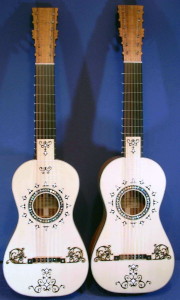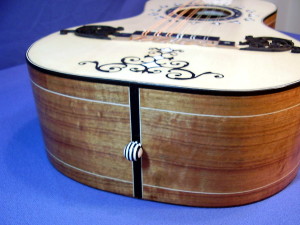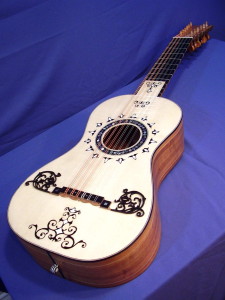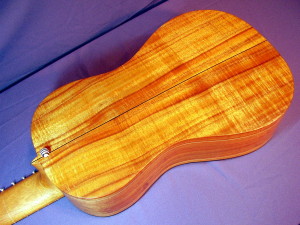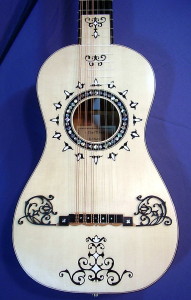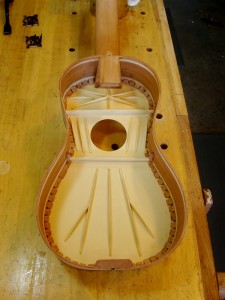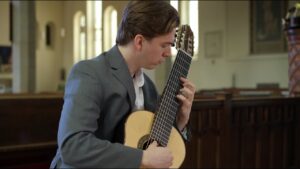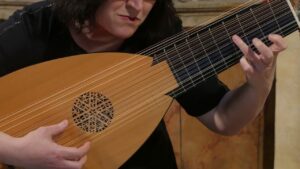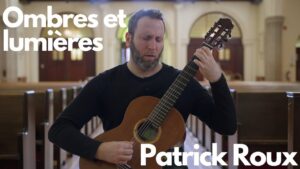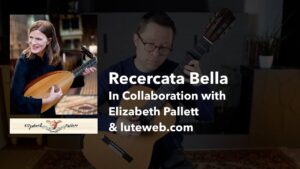This is a guest post by luthier Clive Titmuss
Previously published on Classical Guitar Canada. Make sure to visit his website to see more of his work and recordings. All photos are by Clive Titmuss of guitars he built himself. He mentioned: “I made two of these instruments for my colleague Alan Rinehart and I to play in concert.” You can click on the photos to enlarge them.
An overview of the six-course guitar
The history of the guitar and its music is like a boom and bust economy–periods of efflorescence followed by fallow. The guitar began its current world domination with a raging start in the 17th century. After a slow beginning in the 1450-1550 period, a series of publications in Italy, Spain, France and England set the guitar on a par with other instruments pursued by connoiseurs, amateurs and professionals.
Raised to the level of high art by Guerau, Corbetta and De Visée et al., by the end of the 17th century the guitar began to be played in all strata of society, depicted in many paintings as the must-have accessory for almost anyone who claimed to be educated or literate, entirely replacing the lute except in Germany by the mid-18th century. But in the latter half of 18th century there was a period of retrenchment. The famous picture of the young Mozart at the keyboard, with the opera superstar Farinelli strumming a guitar, says everything we need to know. In this image the guitar is fit primarily to accompany the voice, having lost its own.
Especially in Spain, where we would expect a large repertoire of printed music, there is very little. This comes as a surprise, since there are plenty of pictures, especially the paintings and drawings of Goya, and many extant instruments. What is puzzling is the shadowy transition from an alto-pitched instrument of five courses to a baritone instrument of six, and thence to an early guitar of the 19th century with six single strings. Eventually this path led to an instrument and a tradition that made international stars of Sor, Giuliani, Aguado and others. But what was the substance of the repertoire of the transitional six-course guitar, and what was the stylistic substance of the transition from five to six-course repertoire?
This lacuna of evidence in printed music is partly explained by the effects of war and the decline in the economy of Spain. Inflation and de-population, agrarian collapse and weak and ineffective government made the country a laggard in a period of industrialization as it was experienced in Northern Europe. Perhaps the publishing of music, the teaching of students and even the manufacture of guitars and other instruments may have suffered. Some of the guitar’s impetus migrated, with the last of the Spanish diaspora, to the new world. Santiago de Murcia’s Mexican book, for example, is a notable late flowering of five-course guitar music consisting mainly of variation forms based on dance rhythms and harmonies but with an unmistakeable guitar idiom.
A checklist of published works that are not primarily intended as tutors, and/or including substantial compositions is very short, and furthermore it is music which is rarely played by today’s performers: Antonio Ballestero–Obra para guitarra de seis ordenes… (1799), Antonio Abreu–Escuela para tocar…la guitarra de cinco e seis ordenes (1799), Fernando Ferandière–Arte de tocar…
Federico Moretti figures prominently, but despite having published methods and a notable book of songs, one of the latest occurrences of the phrase “seis ordenes”, he left no solo music. Undated sources from the late 18th century, largely French or Italian in origin, include sonatas and instrumental music with guitar by Amon, Calegari, Doisy, Gragnani, L’Hoyer, Merchi, Molino, Pleyel, Porro and Sheidler.
The style of this late 18th century guitar music derives more from piano and violin music, rather than a native guitar idiom. In this later repertoire the Boccherini quintets with guitar are exceptional in their originality and interest. These pieces are connected with a powerful figure in the guitar’s history in the 18th century–Padre Basilio (Don Miguel Garcia). He was Aguado and Sor’s teacher, and is remembered in a telling and much-quoted passage in Aguado’s method (1825):
In all this time there have doubtless been good players who, captivated by the sweetness of its voices and the effect reproduced by the combining of its sounds, became aficionados; but the were not successfully able to write down what they played. They can be seen in the compositions of Laporta, Arizpacochaga, Abreu, my teacher the so-called Padre Basilio and others; because of these works it is known that these composers went on to be competent performers, and even recognize in part the genius of this instrument, but they were not so successful at putting on paper what they practised with their hands.
This passage is often cited as a manifestation of Aguado’s quest to reform the pedagogy and notation of guitar music. It may equally well be cited as an inference of the lack of elaboration and compositional sophistication in late 18th Century guitar music as compared with the stellar masterpieces of the early 19th Century.
Another aspect in the quest for the repertoire of the six-course guitar is the success with which the Iberian school of harpsichord composers including Scarlatti, Martin y Soler, Albeniz, Cantallos, Rodriguez and the Portuguese, Carlos Seixas, mined its style and idiom for folkloric or rustic effects in their keyboard music. In a pioneering work in English (The Music of Spain, 1941) on the subject of the influence of the guitar in Scarlatti’s harpsichord music, Gilbert Chase noted:
The influence of the guitar upon Scarlatti’s style is manifested in many details of his music. One of the most prominent of these is the internal pedal point, derived from the practice…of steadying the player’s hands by dwelling on one or two notes while the other notes of the harmony are changed. Throughout Scarlatti’s sonatas there are passages that are strongly reminiscent of the style of the early Spanish guitarists…
This passage may equally well apply to any composers for harpsichord, as many others besides Scarlatti were attracted to the vitality of Spanish dance as way of evoking the immediacy of al fresco music performance. The works of Soler, Cantallos, Rodriguez and Albeniz are particulary full of this kind of guitar reference.
In searching for music to play on a newly-constructed six-course guitar after Pages, my curiosity naturally settled on a now-commonplace practice–the transcription of keyboard music of the period as a way of filling out rather thin pickings in the repertoire. Many sonatas by Scarlatti have found a new home on the guitar since Chase’s observation (and in comments made by Ralph Kirkpatrick in his study Domenico Scarlatti), partly as a result of the championing of his music by Vladimir Horowitz, Violet Woodhouse and Wanda Landowska in the 1940’s and 50’s.
Many of the sonatas of the period provide excellent fodder for transcription, and in many ways they illuminate the question of just exactly how the style and music of the early 18th century guitar was carried into the latter half of the century. But I quickly discovered that transcriptions of the material for modern six string guitar did not reflect either the properties of the six-course instrument or the historical values and idioms as they are observed what does exist of the repertoire.
Modern transcriptions can be literal in their transcription of harpsichord texture. What comes easily to two hands, ten fingers, easily ranging over the five octave range of the harpsichord in use in 18th century Spain is suggested on the guitar only with the greatest effort. Passages involving typical feature of the keyboard style such as trills with moving lower voices, acciacature (simultaneous sounding of seconds), pedal points (repetition of dominant or tonic notes as mentioned in the Chase quote above), freely ranging arpeggios, three-handed effects (figuration of the left hand while the right strikes above and below), rapid toccata-style scales, and characteristic keyboard idoms and effects found in the typical Neapolitan binary sonata form do not necessarily make sense on the guitar, even when they have been conceived as imitative of it. Transcription is in itself an art form which proceeds from making the right selection of what to transcribe, so it quickly became apparent that many pieces which might have been written under the spell of six-course idioms really did not appear to work well in their original form.
Though its resources are considerably greater, I found that simply playing modern transcriptions left me feeling that I was working far too hard for the effect which is achieved. The modern guitar, due to its thick overlayed fingerboard, is very even in its voicing along a particular string, its bass and treble are well balanced; its dynamic range is wide. The six-course guitar, like the contemporary harpsichord and the five-course guitar, is highly registered in its colour; the pairing of its (gut) strings means that notes sounded at in a low, medium and very high position sound very different, and the higher you play on any string, slightly and increasingly out of tune. The dynamic range is not as wide as a modern guitar, but strumming and plucking do not have such a distinct character of loud and soft.
Anyone who has heard the blend of “batteries” (chords played with a downward stroke of the index finger) and plucked ( roughly equivalent to “rasgueado” and “punteado”) playing on a baroque period guitar in music by De Visee or Corbetta (late 17th century composers), for example will not be surprised to find that this effect is not necessarily pleasing when exactly duplicated on a modern six-string guitar. The thinness of texture of the early guitar is usually not duplicated in modern transcriptions of the music. Normally the cadential chords are filled, the profusion of ornaments, easily executed on the low-tension strings of the baroque instrument, is reduced when playing a modern guitar.
The properties of the six-course lie somewhere between these extremes, and it became a challenge for me to discover exactly what texture, ornaments and techniques of chordal playing might translate onto a transitional instrument and sound convincingly as if they genuinely belonged to the idiom of the instrument–all in the absence of really satisfactory models, as I discussed above.
Since so many transcriptions of the music of Scarlatti have appeared, I decided to work on pieces that appeared to have more in common with the native speech of the guitar, less in the keyboard idiom of Scarlatti, and to convincingly demonstrate the obvious features of early guitar music, including typical (Italian alfabeto) chord voicings and plucking technique, thinness of texture, and characteristic ornamentation in order to produce a small series of pieces which might form the germ of a set of six sonatas as if they had been composed for the instrument, rather that arranged for it. You’ll find these pieces on my website in pdf format.
This was a guest post by Clive Titmuss
Again, a big thank you to Clive for this epic article. Make sure to visit his website to see more of his work and recordings (earlymusicstudio.com).

